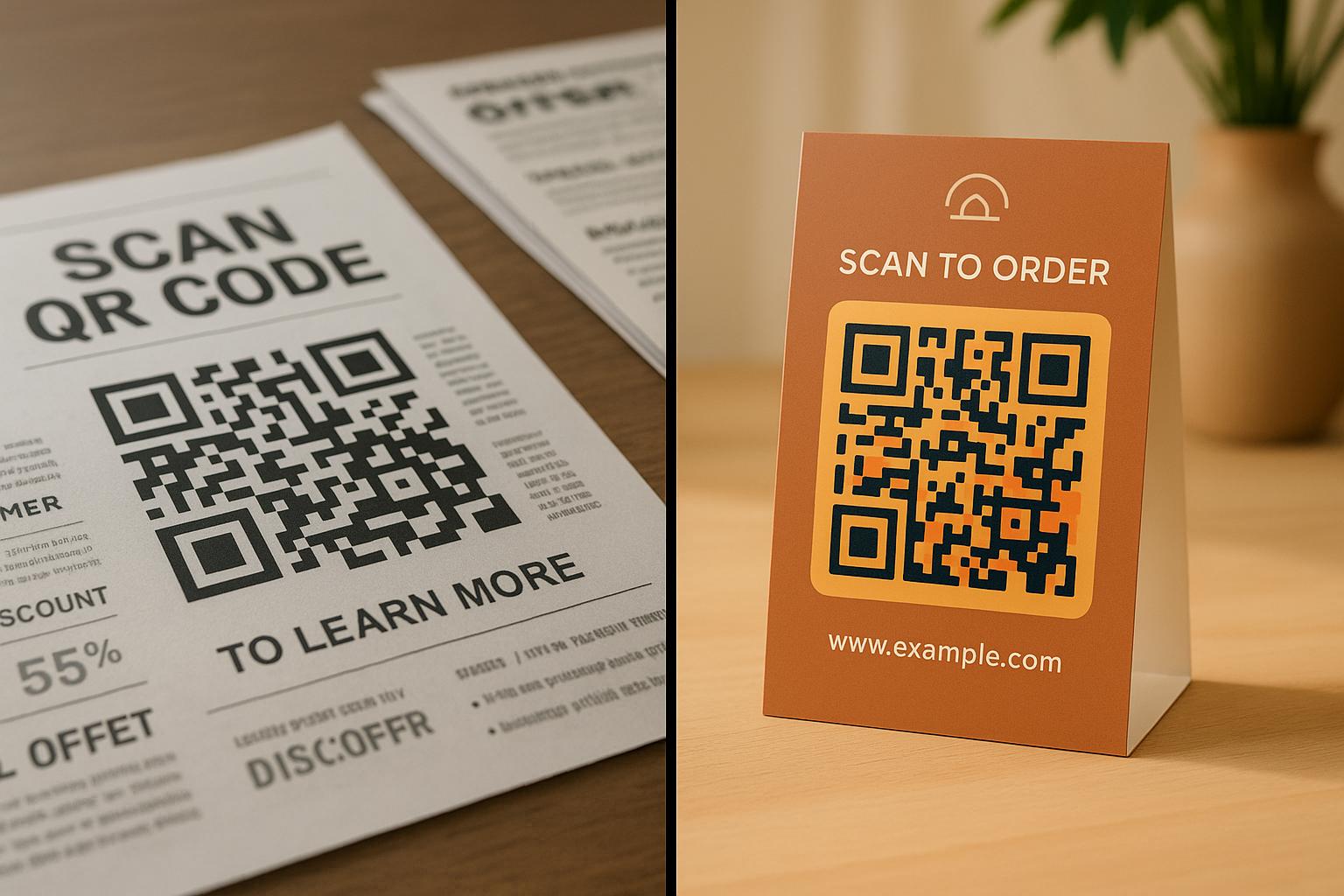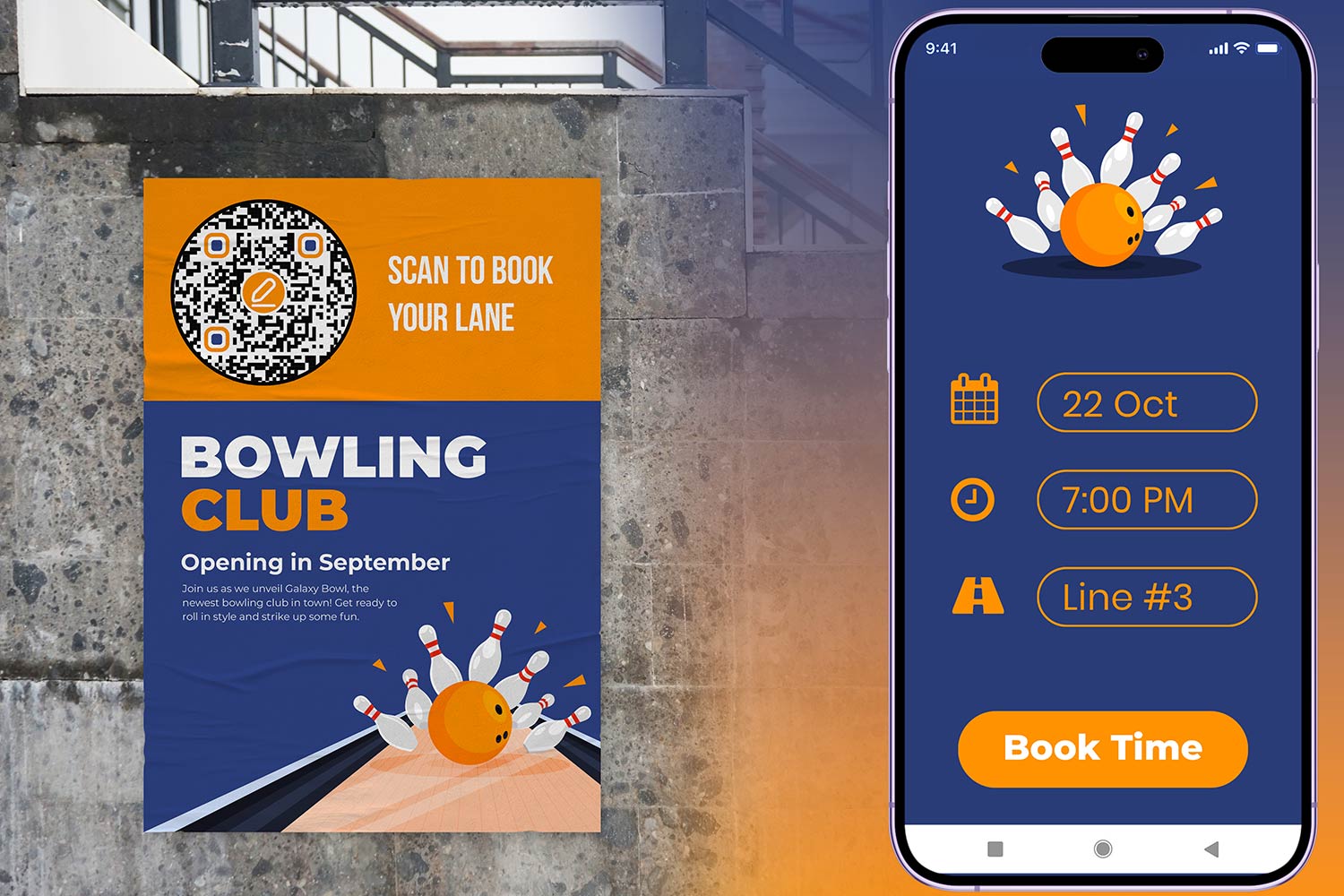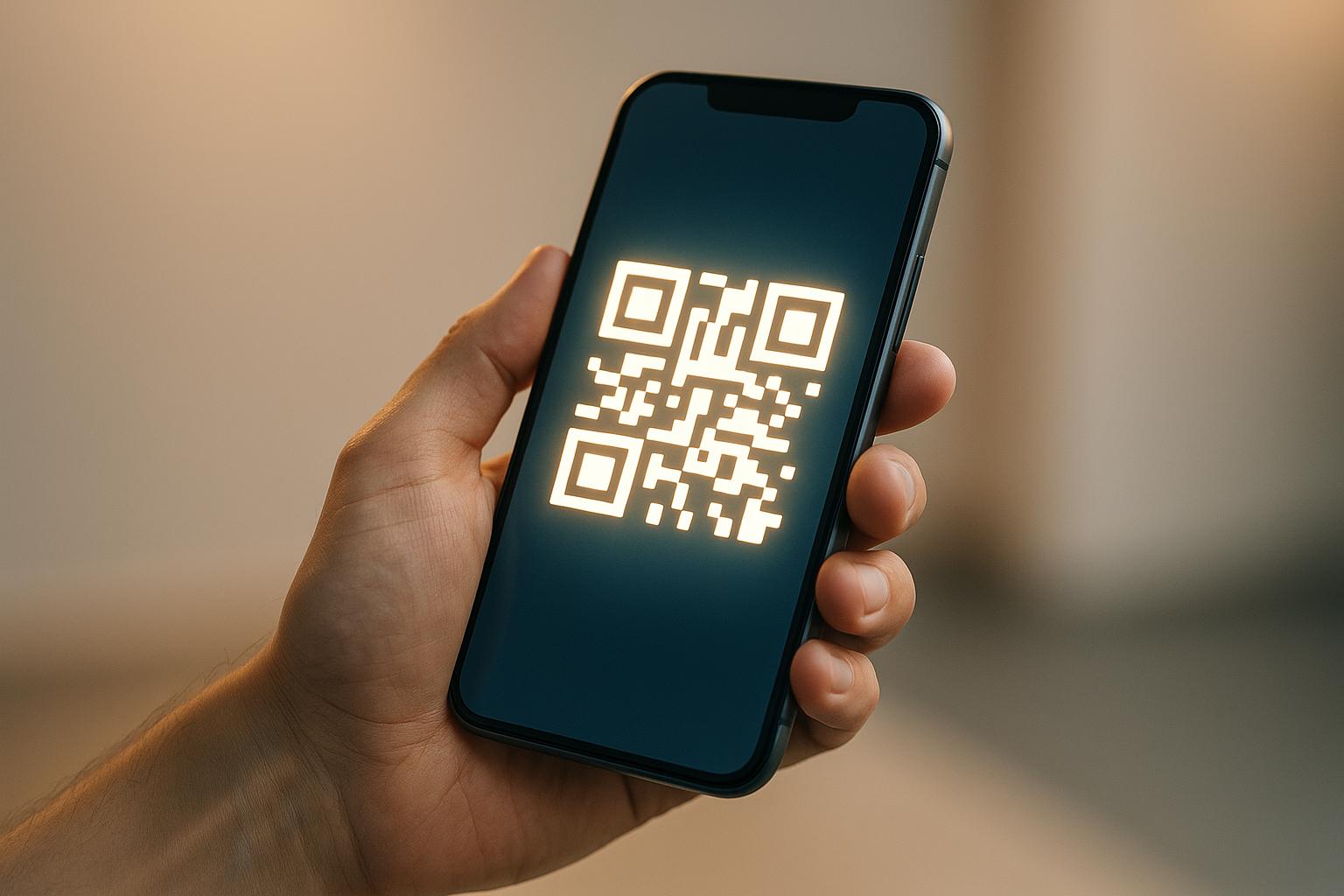A/B testing helps you boost QR code performance by testing different versions of design, placement, and messaging to see what works best. Instead of guessing, you can rely on data to make informed decisions. Here’s what you need to know:
- Test one variable at a time: Focus on elements like color, size, call-to-action (CTA), or placement.
- Dynamic QR codes are key: They allow you to update content without reprinting, making testing easier.
- Track important metrics: Measure scans, conversions, and user behavior to identify what drives results.
- Real-world results: Small changes, like adjusting placement or CTA, can lead to significant increases in engagement.
Static vs Dynamic QR Codes: Which One Should You Use in 2025?
Key elements to test in QR code A/B experiments
When it comes to improving QR code performance, A/B testing plays a vital role in identifying what works best. From color contrast to placement, size, and accessibility, every detail can impact scan rates. Let’s dive into how elements like visual design, messaging, and placement influence QR code success.
Visual design and branding
The way your QR code looks can make or break its effectiveness. High-contrast color combinations are key to ensuring readability. For example, in dimly lit settings, increasing contrast makes scanning easier, while in bright sunlight, avoiding glossy surfaces helps minimize reflection issues that could interfere with scans.
Call-to-action and messaging
The text accompanying your QR code is just as important as the design. A clear, engaging call-to-action (CTA) can greatly influence whether someone decides to scan. Try testing different phrases like "Scan for menu", "Get instant access", or "Unlock exclusive offers" to see which resonates most with your audience. The messaging should not only grab attention but also explain the value of scanning, creating a sense of urgency.
Code placement and visibility
Where you place your QR code determines how likely people are to notice and interact with it. Factors like location, size, and ease of access all come into play.
For optimal visibility, QR codes should be at least 2 cm by 2 cm (0.8 in by 0.8 in), excluding the quiet zone. Additionally, the size should follow a 10:1 distance-to-size ratio – meaning a QR code placed 20 inches away should be at least 2 inches wide. For digital displays, a minimum size of 2.5 inches by 2.5 inches at 72 DPI is recommended.
Positioning also matters. Eye-level placement near relevant content ensures better visibility. Avoid locations that require extra effort, like bending or stretching, and always choose flat, smooth surfaces to prevent distortions from folds or seams. For curved surfaces, such as bottles or cans, slightly increasing the QR code size can maintain readability. Matte finishes are another smart choice, as they reduce glare in bright conditions.
Static vs dynamic QR codes
The type of QR code you use – static or dynamic – can also affect your testing capabilities and overall effectiveness.
- Static QR codes: These are ideal for permanent content that doesn’t change, like Wi-Fi sharing or contact information. However, static codes don’t allow you to update the destination content later, which limits their usefulness for A/B testing.
- Dynamic QR codes: If flexibility is a priority, dynamic QR codes are the way to go. With a dynamic QR code generator, you can update destination content, track detailed analytics, and test different options without needing to reprint the code. Dynamic codes provide valuable insights, such as scan location, time, device type, and user behavior. This makes them perfect for applications like restaurant menus or real estate listings, where content often changes. You can even test different landing pages or seasonal promotions while keeping the same physical QR code.
How to Set Up and Conduct A/B Testing for QR Codes
To get the most out of A/B testing for QR codes, you need to plan carefully and execute systematically. The idea is simple: test one element at a time while keeping everything else the same. This way, you can pinpoint exactly what boosts scan rates and conversions.
Choosing Variations to Test
Start by identifying your campaign goal – whether it’s driving website traffic, increasing app downloads, or encouraging more restaurant menu scans. Your tests should align with this objective. Focus on one variable per test, such as the design of the QR code or the wording of the call-to-action (CTA). Keeping all other factors constant – like test timing – ensures accurate results.
Some impactful elements to test include:
- Color schemes: Try combinations that improve visibility and contrast.
- Calls-to-action: Compare phrases like "Scan for instant access" versus "Get your discount now."
- Landing pages: Test pages offering different incentives or messaging.
For business cards, you could test if adding your company logo to the QR code increases trust and scan rates. For instance, HubSpot found that adding descriptive text to CTAs improved conversions – one variation outperformed the control by 4% because it clarified the offer.
Creating QR Code Variations
Dynamic QR codes are a game-changer for A/B testing because they let you modify destinations without reprinting materials. Using tools like Pageloot’s dynamic QR code generator, you can create multiple versions of a QR code that look the same but lead to different landing pages or track separate metrics.
Start by creating a control QR code to serve as your baseline. Then, change just one element to create a variation. For example:
- If testing visual design, keep the same destination URL and CTA text.
- If testing landing pages, maintain the same QR code design.
Label each variation clearly for easy tracking during analysis. Before rolling out your test, scan each QR code under various conditions (like different lighting or devices) to ensure they work seamlessly. A QR code that doesn’t scan properly can ruin your test results and frustrate users. Once everything is verified, distribute the codes strategically to gather meaningful data.
Distributing QR Codes for Testing
To get reliable results, distribute QR codes in a way that ensures your test groups are comparable. For instance, if you’re testing QR codes on flyers, alternate between version A and version B during distribution. For digital campaigns, use built-in A/B testing tools to split traffic automatically. Tools like A/B test significance calculators can help confirm your results are statistically valid.
Timing also plays a role. Experts suggest testing landing pages within controlled time frames to minimize external influences. Track factors like weather, local events, or the day of the week, as these can affect user behavior. If you’re testing QR codes on posters, make sure the locations have similar foot traffic and demographics for a fair comparison.
Document every detail of your distribution process, including where, when, and how each QR code was used. This record will be critical when analyzing your results and refining future campaigns.
Finally, test across different mediums. QR codes might perform differently on business cards compared to vehicle wraps. Understanding these variations helps you fine-tune each channel while keeping your branding consistent throughout the campaign.
Analyzing A/B Test Results for QR Codes
Once you’ve systematically tested different designs and calls-to-action (CTAs), the next step is digging into the data. This analysis helps you figure out what works and what doesn’t, guiding your next moves. Focus on the metrics that matter most to your QR code campaigns – these numbers separate success stories from lackluster results.
Key Metrics to Measure
Start with scan count and unique scans – the backbone of your analysis. Total scans reveal overall interest, while unique scans show how many individual users interacted with the code. If the ratio of total to unique scans is high, it might mean people are scanning multiple times, which could point to confusion or technical glitches.
Conversion rates go beyond the initial scan to uncover what happens next. Are users completing purchases, signing up for newsletters, or downloading apps after scanning? For context, 89 million people in the U.S. used QR codes in 2022, with most scans coming from smartphones. But keep in mind, scans alone don’t guarantee results – what happens after is what really counts.
Device and location data add valuable context. Tools like Pageloot’s real-time analytics can track where scans happen, what devices and operating systems are used, and even the timing of scans. This granular data can help you fine-tune your targeting.
Here’s an example: A cosmetics brand ran a QR code campaign that initially generated just 168 scans in a week, with a bounce rate over 70%. Analytics showed that 60% of the scans came from Kraków, even though the campaign was meant to be nationwide, and most users accessed the landing page on mobile devices. Armed with this insight, they revamped their mobile-first landing page and shifted their budget to focus on Kraków.
Session duration and pages per session are indicators of user engagement. If people spend time exploring your landing page and clicking through multiple pages, they’re more likely to convert. On the flip side, a high bounce rate might mean your page isn’t meeting user expectations or is too slow to load.
Finally, revenue tracking ties it all back to business outcomes. Use UTM parameters in your QR code URLs to track the source, medium, and campaign name in Google Analytics. This gives you a clear picture of user behavior and the return on investment (ROI) for your campaign.
These metrics help you identify what’s working and where there’s room for improvement, setting the stage for a more effective strategy.
Identifying Successful Elements
Once you’ve gathered the data, look for patterns in what’s driving success. For example, a cosmetics brand tested four QR code variations, comparing plain versus branded designs and different CTAs. The version with a branded design and a personalized CTA – “Find your skincare match” instead of the generic “15% off” – led to 40% more scans and longer landing page visits. This winning design was rolled out nationwide, boosting engagement and conversions.
Visual elements often make a big difference. Compare how QR codes with logos perform versus those without, or test different colors and sizes. Document which designs consistently perform better in specific contexts.
Geographic performance can reveal location-specific trends. For instance, a restaurant placed QR codes on flyers and noticed most scans came from office buildings. They used this insight to launch a targeted lunch promotion in those areas, which increased foot traffic and lunchtime sales.
Timing patterns are another area to explore. Some QR codes might see the most activity during lunch hours, while others perform better in the evening. Use this data to time your campaigns for maximum impact.
Device preferences also matter. If most scans come from mobile devices, make sure your landing pages are optimized for mobile. Test loading speeds across various devices and connection types to reduce drop-offs.
Iterating for Continuous Improvement
Use these insights to refine your next campaign. Instead of making sweeping changes, tweak one element at a time. For example, if branded QR codes outperform plain ones, experiment with different logo sizes or placements. This step-by-step approach helps you pinpoint what truly drives results.
Create feedback loops between your QR code campaigns and your broader marketing strategy. If a particular message resonates in your QR code campaign, consider using it in other channels. Similarly, successful elements from other campaigns might enhance your QR code performance.
Document what works – whether it’s a specific design, placement, or message combination. This knowledge becomes a valuable resource for future campaigns, helping you avoid past mistakes.
Leverage dynamic QR codes to make updates without reprinting materials. You can adjust landing pages, tweak content, or refine user experiences based on performance data. This flexibility allows you to continuously optimize throughout your campaign.
Keep tracking key metrics like total scans, unique scans, conversion rates, geographic data, and device usage. These insights will guide your messaging, design, and placement strategies for better results. Remember, optimizing QR codes isn’t a one-and-done task – it’s an ongoing process.
sbb-itb-74874c9
Integrating A/B Testing with Marketing Tools and Automation
When A/B testing insights are seamlessly integrated into your marketing ecosystem – spanning automated workflows, CRM systems, and personalization tools – they become a powerful driver of smarter strategies. This integration enables advanced analytics and personalization opportunities that can significantly enhance your marketing efforts.
Using QR Code Analytics
QR code analytics provide a wealth of data that can refine your marketing strategies. Tools like Pageloot offer real-time insights into scan frequency, location, device types, and timing. When combined with your existing marketing stack, this data delivers a complete view of the customer journey – from the initial scan to website navigation and conversion.
Take Google Analytics as an example. By integrating QR code data, you can see how users interact after scanning, such as which pages they visit and whether they complete desired actions. This helps pinpoint which QR code variations drive meaningful engagement, not just high scan counts.
Different industries have already tapped into this potential. A skincare brand used QR codes on product packaging to link customers to personalized skincare guides. Analytics revealed higher engagement in humid regions, leading to the launch of moisture-focused product lines tailored to those markets. Similarly, a clothing retailer placed QR codes at checkout for exclusive discounts. When data showed that 60% of scans happened on weekends, they introduced weekend-only flash sales, boosting revenue significantly.
Focus on the metrics that align with your goals. For instance:
- Scan rates measure initial interest.
- Conversion rates show the true impact on your business.
- Location data helps fine-tune geographic targeting.
- Device type insights ensure your landing pages are optimized across platforms.
- Time-based trends can guide automated campaigns during peak engagement hours.
Using QR Codes for Personalized Campaigns
Dynamic QR codes open the door to personalized campaigns that can adapt in real-time. For example, you can segment audiences based on their scan behavior to create targeted messaging. A café that noticed a drop in QR code menu scans after 8 PM launched a late-night promotion to re-engage customers. Similarly, a company at a trade event adjusted follow-up emails based on the scanning habits of finance professionals visiting their booth.
Geographic personalization adds another layer of relevance. A hotel placed QR codes in guest rooms linking to local attraction guides. Analytics showed that tourists from specific countries were scanning the codes most often, prompting the creation of localized travel guides in multiple languages. Each scan triggered tailored content based on the user’s likely origin, enhancing the guest experience.
Dynamic QR codes also allow for instant updates. If A/B testing reveals that a particular message resonates better with a specific audience, you can update the linked content without reprinting materials. This flexibility ensures that your campaigns stay relevant and effective, making QR codes a dynamic tool in your marketing arsenal.
Streamlining Workflows with Automation
Automation takes the potential of QR codes even further by turning scan data into actionable workflows. Marketing platforms like HubSpot and ActiveCampaign can use QR code scans as triggers to initiate personalized customer journeys. For example:
- Scanning a QR code on a business card could automatically add a contact to an email nurture sequence.
- Scanning a product QR code might trigger an abandoned cart email if the user doesn’t complete a purchase.
This approach also refines lead segmentation. A user scanning for premium content might receive a different follow-up than someone scanning for a basic discount, ensuring messages stay relevant throughout the customer journey.
Timing is another area where automation shines. For instance, a coffee shop tracked QR code scans on its mobile truck and found peak activity near office parks during weekday lunch hours. By automating social media posts and email promotions to align with these times, the shop doubled its redemption rates.
Automation can streamline campaign management, too. Instead of manually creating and testing multiple QR code variations, workflows can handle everything – from generating new codes to distributing them across channels and compiling performance data. This ensures consistent testing and optimization without overloading your team.
With 84% of people more likely to scan QR codes when offers are relevant, combining A/B testing insights with marketing automation creates a powerful feedback loop. Each scan generates valuable data that informs future personalization, while improved personalization drives higher scan rates and conversions. This cycle transforms QR codes from simple tools into sophisticated assets that continuously adapt and deliver results.
Conclusion: Achieving Better Conversions with QR Code A/B Testing
A/B testing takes QR codes beyond their basic function as scanning tools, turning them into effective drivers of conversions. Yet, nearly half of campaigns – about 45% – fall short due to inadequate tracking efforts.
Key Takeaways
The backbone of successful QR code campaigns is systematic testing and measurement. Experimenting with visual designs, call-to-action messages, placement strategies, and code types helps uncover what resonates most with your audience.
Dynamic QR codes stand out because they allow updates without the need to reprint materials. This flexibility matters, especially since 84% of people are more likely to scan a QR code when the offer is relevant to them.
Integrating QR code analytics into your marketing tools gives you valuable insights into customer behavior. Metrics like scan frequency, geographic data, device preferences, and timing patterns help refine your strategy. For example, a coffee shop used QR code data from its mobile truck to identify peak scanning times near office parks during weekday lunches. Adjusting their schedule based on this insight led to a doubling of their redemption rates.
Personalization is another game-changer. By segmenting audiences based on scanning behavior, you can deliver targeted messages that go beyond generic interactions. For instance, a fitness brand discovered that 70% of its QR code scans came from Android users. This insight helped them focus their app development efforts, resulting in better app store ratings and improved user retention.
These strategies provide a clear path for improving your campaigns.
Next Steps for Marketers
To maximize the potential of QR codes, start by refining your tracking and measurement processes. If you’re not already monitoring scan rates, conversion rates, and user behavior, you’re missing out on key optimization opportunities. Begin with simple A/B tests – compare different visual designs or call-to-action messages within your current campaigns.
Choose tools that align with your testing needs. Platforms like Pageloot offer dynamic QR code creation and real-time analytics, allowing you to update content or test new designs without reprinting materials.
Make iteration a continuous process. As Alfredo Colas, Senior Vice President of Data, Analytics, and Digital Go-to-Market at P&G, puts it:
"The best use cases (of QR Codes) are probably the ones we’re not yet thinking of".
This highlights the importance of ongoing experimentation and adaptation.
From the start, implement robust tracking. Add UTM parameters to your QR code URLs so you can monitor performance through Google Analytics. Set clear metrics that align with your business goals. Whether you’re using QR codes on business cards, flyers, or product packaging, consistent measurement is key to making informed decisions.
These principles apply across industries. Restaurants can use QR codes for digital menus, while real estate agents can share property details. The process is universal: start small, measure consistently, and let the data guide your decisions. When you create a QR code with testing in mind, you’re not just generating a tool for scanning – you’re building a conversion engine that improves with every campaign.
FAQs
What should I test first when running A/B tests on QR codes?
Deciding What to Test First in QR Code A/B Testing
Start by examining your current performance metrics. Pinpoint areas where engagement falls short – like low scan rates or conversions. These are the spots where changes can make a noticeable difference.
Focus on tweaking high-impact elements such as the QR code’s design, placement, or content. For instance, you could try adjusting the colors, resizing the code, or reworking the call-to-action text. The key is to test one element at a time. This way, it’s easier to pinpoint what’s driving the improvements. By taking this step-by-step approach, you’ll be able to fine-tune your QR codes and make smarter, data-backed decisions.
Why are dynamic QR codes better than static ones for A/B testing?
Dynamic QR codes have revolutionized A/B testing by making it possible to update the content linked to the code without reprinting. This flexibility lets you experiment with different designs, placements, or messages in real-time, which can save both time and resources.
What sets dynamic QR codes apart is their ability to provide detailed analytics. You can track information like where and when a code was scanned, as well as the type of device used. These insights give you a clearer picture of user behavior, enabling smarter decisions to fine-tune campaigns and boost conversions. In contrast, static QR codes lack this adaptability and tracking ability, which is why marketers aiming for higher engagement often turn to dynamic codes.
How can I use QR code analytics to improve my marketing campaigns?
To make your marketing campaigns more effective with QR code analytics, start by using tools that provide detailed tracking data. Adding UTM parameters to the URLs embedded in your QR codes allows you to track user activity and measure campaign performance through platforms like Google Analytics. This approach helps you gain insights into scan rates, user behavior, and conversion paths.
For a more convenient solution, platforms like Pageloot come with built-in analytics dashboards. These tools let you monitor scans in real-time, spot trends, and quickly adjust your strategies. With these insights, you can fine-tune your QR code designs, optimize their placement, and improve the content they lead to, ultimately boosting engagement and results. Pairing analytics with marketing tools lets you make smarter, data-backed decisions for your campaigns.

























